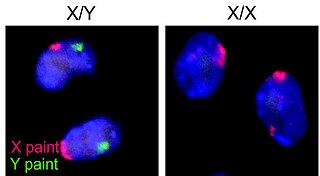| Sciara | |
|---|---|
 | |
| Sciara species | |
| Scientific classification | |
| Kingdom: | Animalia |
| Phylum: | Arthropoda |
| Class: | Insecta |
| Order: | Diptera |
| Family: | Sciaridae |
| Genus: | Sciara Meigen, 1803 |
| Synonyms [1] | |
Sciara is a genus of fungus gnats in the family Sciaridae. [2]
| Sciara | |
|---|---|
 | |
| Sciara species | |
| Scientific classification | |
| Kingdom: | Animalia |
| Phylum: | Arthropoda |
| Class: | Insecta |
| Order: | Diptera |
| Family: | Sciaridae |
| Genus: | Sciara Meigen, 1803 |
| Synonyms [1] | |
Sciara is a genus of fungus gnats in the family Sciaridae. [2]


Sciara is among the largest genus in the world, with over 700 species. Species within this genus include: [3] [4]
The adult fly is small, up to 3 mm, has a dark brown body, small head and its legs and wings are comparatively long, looking like a mosquito.
These insects feed on decaying organic matter and fungi. They are often found in greenhouses. Their larvae are up to 6 mm long, white, slender and legless, with a black head and smooth semi-transparent skin which reveals the contents of the digestive tract.
Sex determination in Sciara is a different mechanism. Sciara basically has 4 pairs of chromosomes 3 pairs of autosomes and one pair of allosomes. Some special chromosomes called limited chromosomes are present in certain stages. The zygote has 3 pairs of autosomes a one or more limited chromosomes and 3 X chromosome (2 fathers’, 1 mother's). There are 2 stages in Sciara: the Germ line and the Somaline. [5] [6]
The Germ line is the gametic line where the gamete formation takes place. The number of chromosomes during this line is different in males and females.
In the formation sperms of males the 1st spermatocystic division is monocentric mitosis, the maternal and paternal homologous chromosomes are separated. Then few limited chromosomes are eliminated not all of them. After this one paternal X chromosome is also eliminated. Hence male germ line (spermatogonia) cells have 3 pairs of autosomes, 2 (one maternal and one paternal) X chromosomes and a few limited chromosomes.
In the formation ova of the females the 1st ovarian division is monocentric mitosis, the maternal and paternal homologous chromosomes are separated. Then few limited chromosomes are eliminated not all of them. After this both 2 paternal X chromosome are also eliminated. Hence female germ line (oogonia) cells have 3 pairs of autosomes, 1 maternal X chromosomes and a few limited chromosomes.
Soma line is the vegetative stage. During early cleavage stages of the embryo limited chromosomes are eliminated. The number of chromosomes during this line is different in males and females.
In males during the 5th and 6th divisions of the embryo all the limited chromosomes are eliminated. Then paternal X chromosome is eliminated which are 2 in number. Hence male soma line cells have 3 pairs of autosomes and one maternal X chromosome.
In the females during the 5th and 6th divisions of the embryo all the limited chromosomes are eliminated. In the next stage of cleavage one paternal X chromosome is eliminated. Hence female soma line cells have 3 pairs of autosomes and one maternal and one paternal X chromosome.

An autosome is any chromosome that is not a sex chromosome. The members of an autosome pair in a diploid cell have the same morphology, unlike those in allosome pairs which may have different structures. The DNA in autosomes is collectively known as atDNA or auDNA.

A gamete is a haploid cell that fuses with another haploid cell during fertilization in organisms that sexually reproduce and possess only one set of dissimilar chromosomes. Gametes are an organism's reproductive cells, also referred to as sex cells. In species that produce two morphologically distinct types of gametes, and in which each individual produces only one type, a female is any individual that produces the larger type of gamete—called an ovum— and a male produces the smaller tadpole-like type—called a sperm. Sperm cells or spermatozoon are small and motile due to the flagellum, a tail-shaped structure that allows the cell to propel and move. In contrast, each egg cell or ovum is relatively large and non-motile. In short a gamete is an egg cell or a sperm. Ova mature in the ovaries of females and sperm develop in the testes of males. During fertilization, a spermatozoon and ovum unite to form a new diploid organism. Gametes carry half the genetic information of an individual, one ploidy of each type, and are created through meiosis, in which a germ cell undergoes two fissions, resulting in the production of four gametes. In biology, the type of gamete one produces determines the classification of their sex.
Genomic imprinting is an epigenetic phenomenon that causes genes to be expressed in a parent-of-origin-specific manner. Genes however, can also be partially imprinted. Partial imprinting happens when alleles from both parents are differently expressed rather than complete expression and complete suppression of one parents allele. Forms of genomic imprinting have been demonstrated in fungi, plants and animals. As of 2014, there are about 150 imprinted genes known in the mouse and about half that in humans. In 2019, 260 imprinted genes have been reported in mice and 228 in humans.

Meiosis is a special type of cell division of germ cells in sexually-reproducing organisms used to produce the gametes, such as sperm or egg cells. It involves two rounds of division that ultimately result in four cells with only one copy of each paternal and maternal chromosome (haploid). Additionally, prior to the division, genetic material from the paternal and maternal copies of each chromosome is crossed over, creating new combinations of code on each chromosome. Later on, during fertilisation, the haploid cells produced by meiosis from a male and female will fuse to create a cell with two copies of each chromosome again, the zygote.

Karyotyping is the process by which photographs of chromosomes are taken in order to determine the chromosome complement of an individual, including the number of chromosomes and any abnormalities. The term is also used for the complete set of chromosomes in a species or in an individual organism and for a test that detects this complement or measures the number.
A somatic cell, or vegetal cell, is any biological cell forming the body of an organism; that is, in a multicellular organism, any cell other than a gamete, germ cell, gametocyte or undifferentiated stem cell.

The Y chromosome is one of two sex chromosomes (allosomes) in therian mammals, including humans, and many other animals. The other is the X chromosome. Y is normally the sex-determining chromosome in many species, since it is the presence or absence of Y that typically determines the male or female sex of offspring produced in sexual reproduction. In mammals, the Y chromosome contains the gene SRY, which triggers male development. The DNA in the human Y chromosome is composed of about 59 million base pairs. The Y chromosome is passed only from father to son. With a 30% difference between humans and chimpanzees, the Y chromosome is one of the fastest-evolving parts of the human genome. The human Y chromosome carries an estimated 100-200 genes, with between 45 and 73 of these protein-coding. All single-copy Y-linked genes are hemizygous except in cases of aneuploidy such as XYY syndrome or XXYY syndrome.

A couple of homologous chromosomes, or homologs, are a set of one maternal and one paternal chromosome that pair up with each other inside a cell during fertilization. Homologs have the same genes in the same loci where they provide points along each chromosome which enable a pair of chromosomes to align correctly with each other before separating during meiosis. This is the basis for Mendelian inheritance which characterizes inheritance patterns of genetic material from an organism to its offspring parent developmental cell at the given time and area.

A germ cell is any biological cell that gives rise to the gametes of an organism that reproduces sexually. In many animals, the germ cells originate in the primitive streak and migrate via the gut of an embryo to the developing gonads. There, they undergo meiosis, followed by cellular differentiation into mature gametes, either eggs or sperm. Unlike animals, plants do not have germ cells designated in early development. Instead, germ cells can arise from somatic cells in the adult, such as the floral meristem of flowering plants.

Nondisjunction is the failure of homologous chromosomes or sister chromatids to separate properly during cell division. There are three forms of nondisjunction: failure of a pair of homologous chromosomes to separate in meiosis I, failure of sister chromatids to separate during meiosis II, and failure of sister chromatids to separate during mitosis. Nondisjunction results in daughter cells with abnormal chromosome numbers (aneuploidy).
An oocyte, oöcyte, ovocyte, or rarely ocyte, is a female gametocyte or germ cell involved in reproduction. In other words, it is an immature ovum, or egg cell. An oocyte is produced in the ovary during female gametogenesis. The female germ cells produce a primordial germ cell (PGC), which then undergoes mitosis, forming oogonia. During oogenesis, the oogonia become primary oocytes. An oocyte is a form of genetic material that can be collected for cryoconservation. Cryoconservation of animal genetic resources has been put into action as a means of conserving traditional livestock.

Dosage compensation is the process by which organisms equalize the expression of genes between members of different biological sexes. Across species, different sexes are often characterized by different types and numbers of sex chromosomes. In order to neutralize the large difference in gene dosage produced by differing numbers of sex chromosomes among the sexes, various evolutionary branches have acquired various methods to equalize gene expression among the sexes. Because sex chromosomes contain different numbers of genes, different species of organisms have developed different mechanisms to cope with this inequality. Replicating the actual gene is impossible; thus organisms instead equalize the expression from each gene. For example, in humans, females (XX) silence the transcription of one X chromosome of each pair, and transcribe all information from the other, expressed X chromosome. Thus, human females have the same number of expressed X-linked genes as do human males (XY), both sexes having essentially one X chromosome per cell, from which to transcribe and express genes.

X-inactivation is a process by which one of the copies of the X chromosome is inactivated in therian female mammals. The inactive X chromosome is silenced by it being packaged into a transcriptionally inactive structure called heterochromatin. As nearly all female mammals have two X chromosomes, X-inactivation prevents them from having twice as many X chromosome gene products as males, who only possess a single copy of the X chromosome.
Gametogonium are stem cells for gametes located within the gonads. They originate from primordial germ cells, which have migrated to the gonads. Male gametogonia which are located within the testes during development and adulthood are called spermatogonium. Female gametogonia, known as oogonium, are found within the ovaries of the developing foetus and were thought to be depleted at or after birth. Spermatogonia and oogonia are classified as sexually differentiated germ cells.
An oogonium is a small diploid cell which, upon maturation, forms a primordial follicle in a female fetus or the female gametangium of certain thallophytes.

Synapsis is the pairing of two chromosomes that occurs during meiosis. It allows matching-up of homologous pairs prior to their segregation, and possible chromosomal crossover between them. Synapsis takes place during prophase I of meiosis. When homologous chromosomes synapse, their ends are first attached to the nuclear envelope. These end-membrane complexes then migrate, assisted by the extranuclear cytoskeleton, until matching ends have been paired. Then the intervening regions of the chromosome are brought together, and may be connected by a protein-RNA complex called the synaptonemal complex. Autosomes undergo synapsis during meiosis, and are held together by a protein complex along the whole length of the chromosomes called the synaptonemal complex. Sex chromosomes also undergo synapsis; however, the synaptonemal protein complex that holds the homologous chromosomes together is only present at one end of each sex chromosome.
P elements are transposable elements that were discovered in Drosophila as the causative agents of genetic traits called hybrid dysgenesis. The transposon is responsible for the P trait of the P element and it is found only in wild flies. They are also found in many other eukaryotes.

The Sciaridae are a family of flies, commonly known as dark-winged fungus gnats. Commonly found in moist environments, they are known to be a pest of mushroom farms and are commonly found in household plant pots. This is one of the least studied of the large Diptera families, probably due to the small size of these insects and the difficulty in specific identification.

A sex chromosome, is a chromosome that differs from an ordinary autosome in form, size, and behavior. The human sex chromosomes, a typical pair of mammal allosomes, determine the sex of an individual created in sexual reproduction. Autosomes differ from allosomes because autosomes appear in pairs whose members have the same form but differ from other pairs in a diploid cell, whereas members of an allosome pair may differ from one another and thereby determine sex.
Non-random segregation of chromosomes is a deviation from the usual distribution of chromosomes during meiosis, that is, during segregation of the genome among gametes. While usually according to the 2nd Mendelian rule homologous chromosomes are randomly distributed among daughter nuclei, there are various modes deviating from this in numerous organisms that are "normal" in the relevant taxa. They may involve single chromosome pairs (bivalents) or single chromosomes without mating partners (univalents), or even whole sets of chromosomes, in that these are separated according to their parental origin and, as a rule, only those of maternal origin are passed on to the offspring. It also happens that non-homologous chromosomes segregate in a coordinated manner. As a result, this is a form of Non-Mendelian inheritance.
| Wikispecies has information related to Sciara (gnat) . |
| Wikimedia Commons has media related to Sciara . |